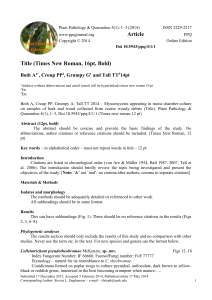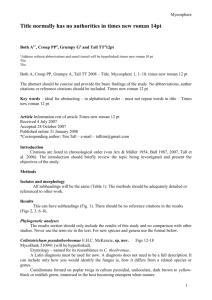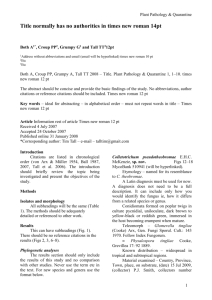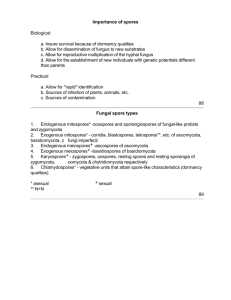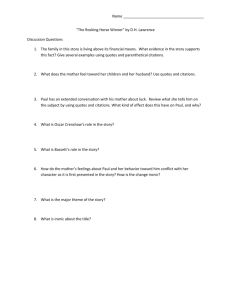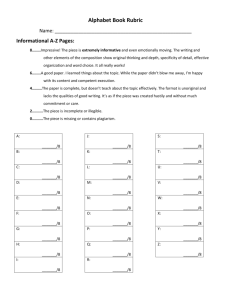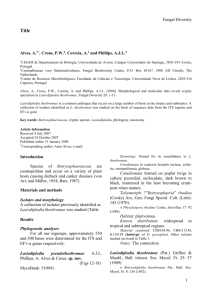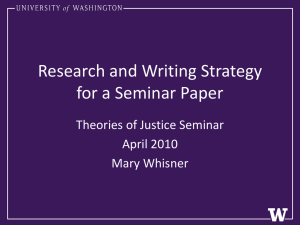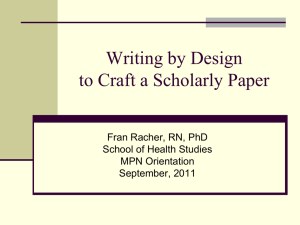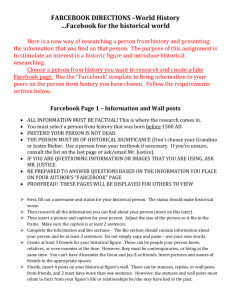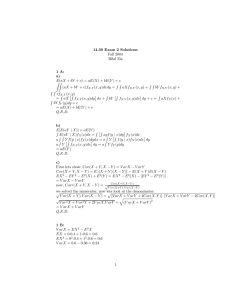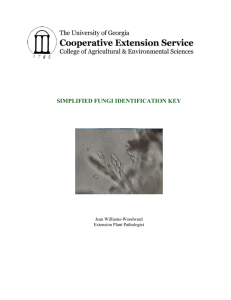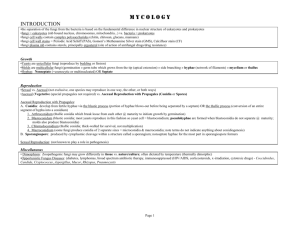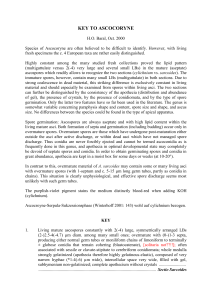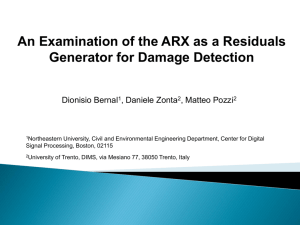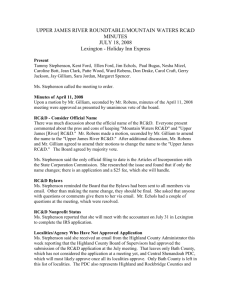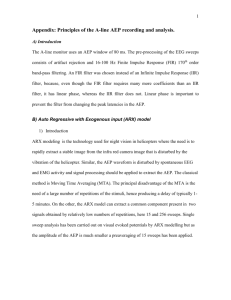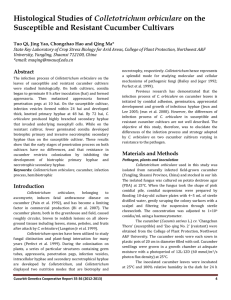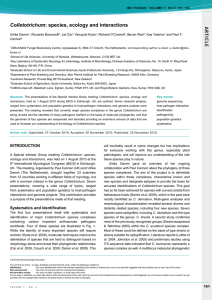The template can be downloaded here.
advertisement
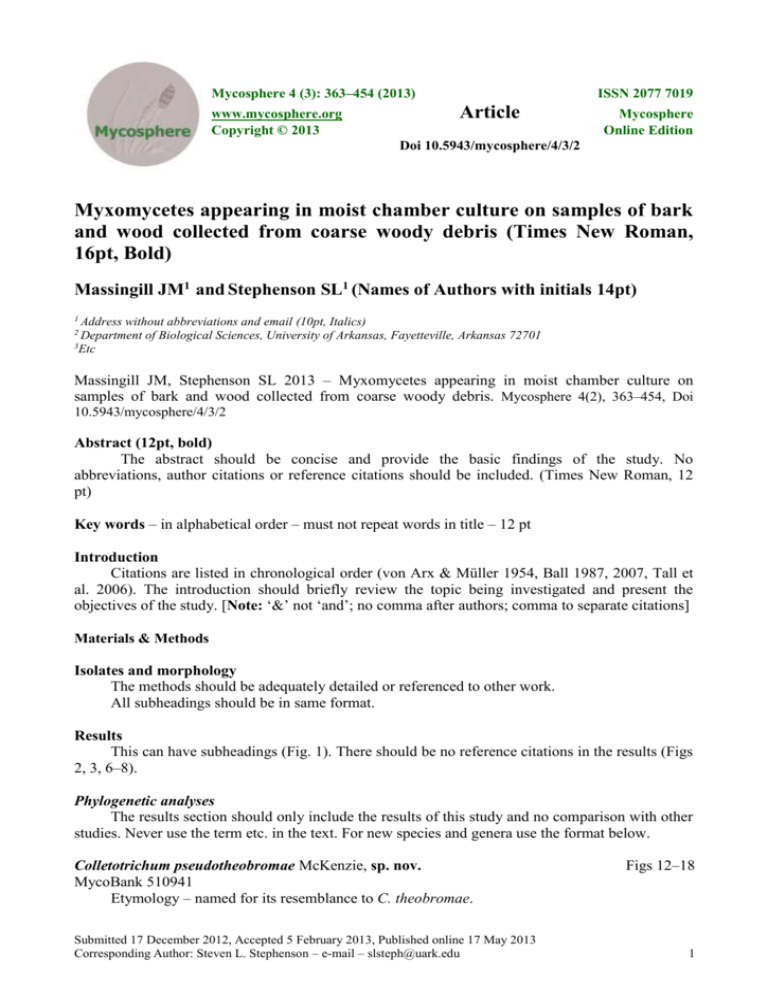
Mycosphere 4 (3): 363–454 (2013) www.mycosphere.org Copyright © 2013 ISSN 2077 7019 Article Mycosphere Online Edition Doi 10.5943/mycosphere/4/3/2 Myxomycetes appearing in moist chamber culture on samples of bark and wood collected from coarse woody debris (Times New Roman, 16pt, Bold) Massingill JM1 and Stephenson SL1 (Names of Authors with initials 14pt) 1 Address without abbreviations and email (10pt, Italics) Department of Biological Sciences, University of Arkansas, Fayetteville, Arkansas 72701 3 Etc 2 Massingill JM, Stephenson SL 2013 – Myxomycetes appearing in moist chamber culture on samples of bark and wood collected from coarse woody debris. Mycosphere 4(2), 363–454, Doi 10.5943/mycosphere/4/3/2 Abstract (12pt, bold) The abstract should be concise and provide the basic findings of the study. No abbreviations, author citations or reference citations should be included. (Times New Roman, 12 pt) Key words – in alphabetical order – must not repeat words in title – 12 pt Introduction Citations are listed in chronological order (von Arx & Müller 1954, Ball 1987, 2007, Tall et al. 2006). The introduction should briefly review the topic being investigated and present the objectives of the study. [Note: ‘&’ not ‘and’; no comma after authors; comma to separate citations] Materials & Methods Isolates and morphology The methods should be adequately detailed or referenced to other work. All subheadings should be in same format. Results This can have subheadings (Fig. 1). There should be no reference citations in the results (Figs 2, 3, 6–8). Phylogenetic analyses The results section should only include the results of this study and no comparison with other studies. Never use the term etc. in the text. For new species and genera use the format below. Colletotrichum pseudotheobromae McKenzie, sp. nov. MycoBank 510941 Etymology – named for its resemblance to C. theobromae. Submitted 17 December 2012, Accepted 5 February 2013, Published online 17 May 2013 Corresponding Author: Steven L. Stephenson – e-mail – slsteph@uark.edu Figs 12–18 1 Conidiomata formed on poplar twigs in culture pycnidial, uniloculate, dark brown to yellowblack or reddish green, immersed in the host becoming erumpent when mature….. Teleomorph – Glomerella tingliae (Cooke) Arx, Gen. Fungi Sporul. Cult.: 143 1970. Follow Index Fungorum. Physalospora tingliae Cooke, Grevillea 17: 92 1889. Known distribution – widespread in tropical and subtropical regions. Material examined – Country, Province, Town, place, on substrate, (date) 15 Jul 2009, (collector) P.J. Smith, collectors number (herbarium, state if holotype or other type) – ex-type culture in CBC Notes – The connection…. Key to Fungus species 1. Text Text Text Text .................................................................................................................... Text 2. Text Text Text Text ........................................................................................... Text Text Text Text 3. Text Text Text Text ........................................................................................... Text Text Text Text Discussion This is where you compare your work with other research and put forward and discuss your major findings (Table 1). There must be adequate comparison and references to previous work. Table 1 Conidial size and septation of selected Colletotrichum species. Species richness Species evenness Shannon indices Shannon evenness Magnolia liliifera Stage I* Stage II* 23 21 88 44 2.84 2.9 0.74 0.84 Cinnamomum iners Stage I* Stage II* 14 9 24 17 2.56 2.1 0.92 0.9 Figures 2–11 – Colletotrichum thingliae. 2, 3, 5, 6, 10, 11 CBS164.96 2 Paraphyses. 3, 4 Conidiogenous cells and young conidia. 5, 6 Mature conidia in two different focal planes to show the longitudinal striations. 10, 11 Hyaline, immature conidia. 4, 7, 8, 9, K118158 4 Conidiogenous layer with paraphyses. 7, 8 Mature conidia in two different focal planes to show the longitudinal striations. 9 Conidia. – Bars = 10 µm. This picture is copyright of Michael Pilkington. 2 Acknowledgements This work was financed by the European…. References Alfaro ME, Zoller S, Lutzoni F. 2003 – Bayes or bootstrap? A simulation study comparing the performance of Bayesian Markov chain Monte Carlo sampling and bootstrapping in assessing phylogenetic confidence. Molecular Biology and Evolution 20, 255–266. Anon 2001–2009 – NZFungi database of New Zealand fungi. Landcare Research, New Zealand. http://nzfungi.landcareresearch.co.nz (accessed 14 May 2013). Arx JA von 1981 – The Genera of Fungi Sporulating in Pure Culture. J. Cramer, Vaduz. Piasai O, Manoch L. 2009a – Coprophilous ascomycetes from Phu Luang Wildlife Sanctuary and Khao Yai National Park in Thailand. Kasetsart Journal (National Sciences) 43, 34–40. Piasai O, Manoch L. 2009b – Diversity of microfungi from animal excrement at Ko Samaesarn and Mu Ko Angthong National Park; 35th Congress on Science and Technology of Thailand. Department of Plant Pathology, Faculty of Agriculture, Kasetsart University, Bangkok. www.indexfungorum.org – 2011. Note: Page margins must be 0.8" each side Page size must be A4 3
